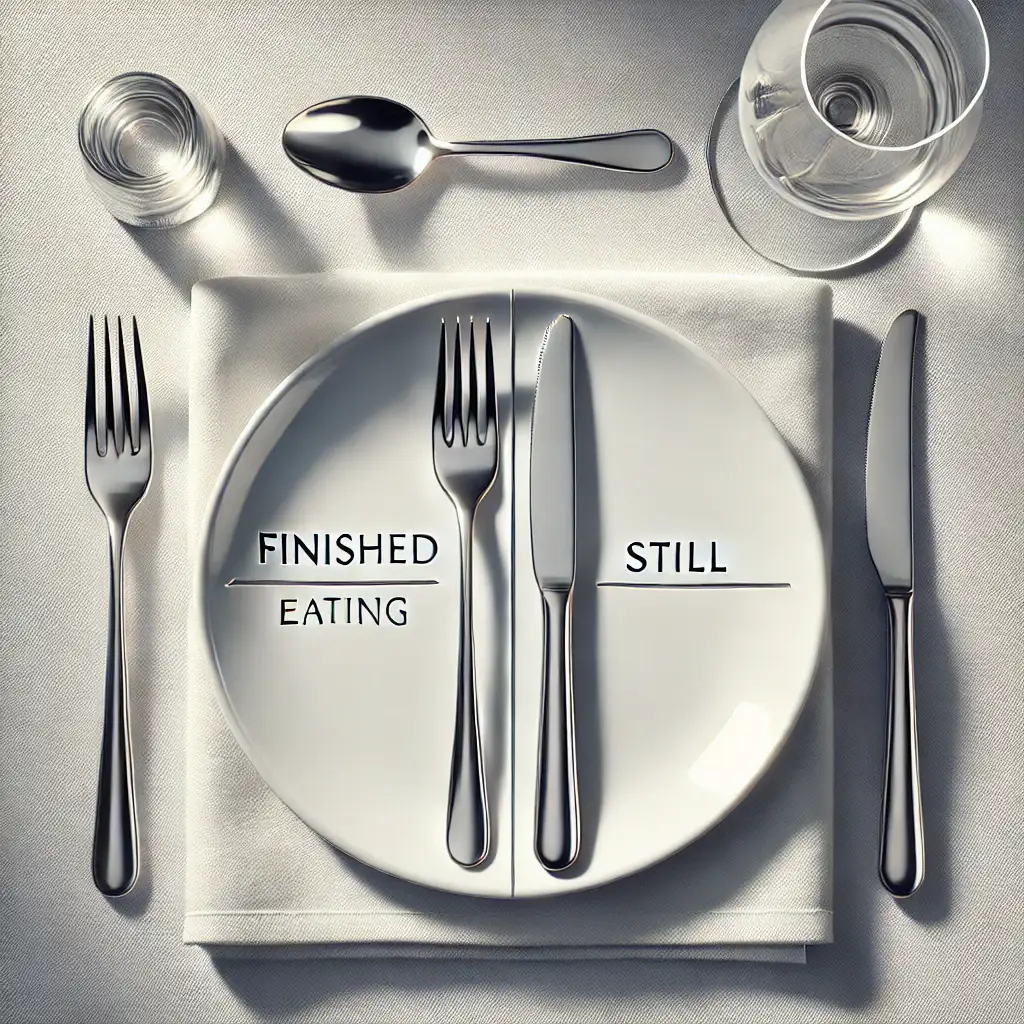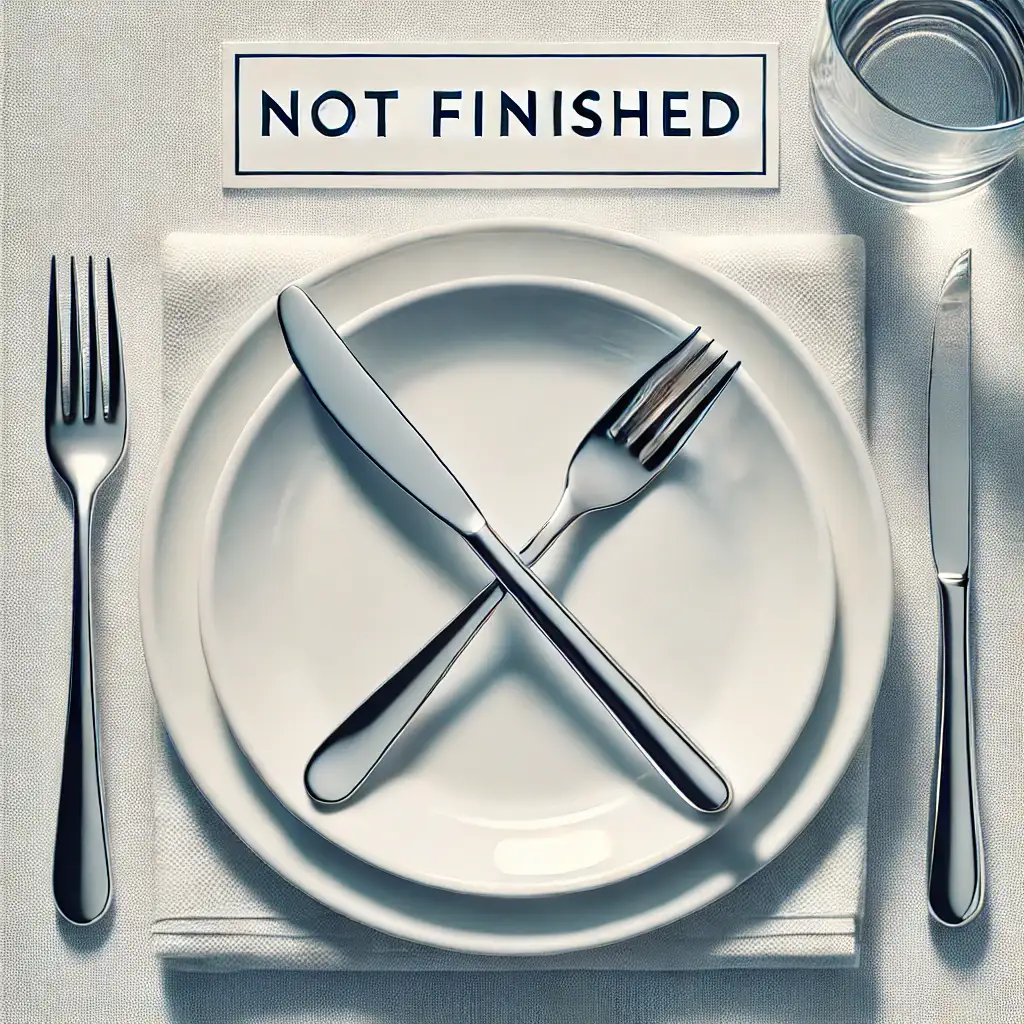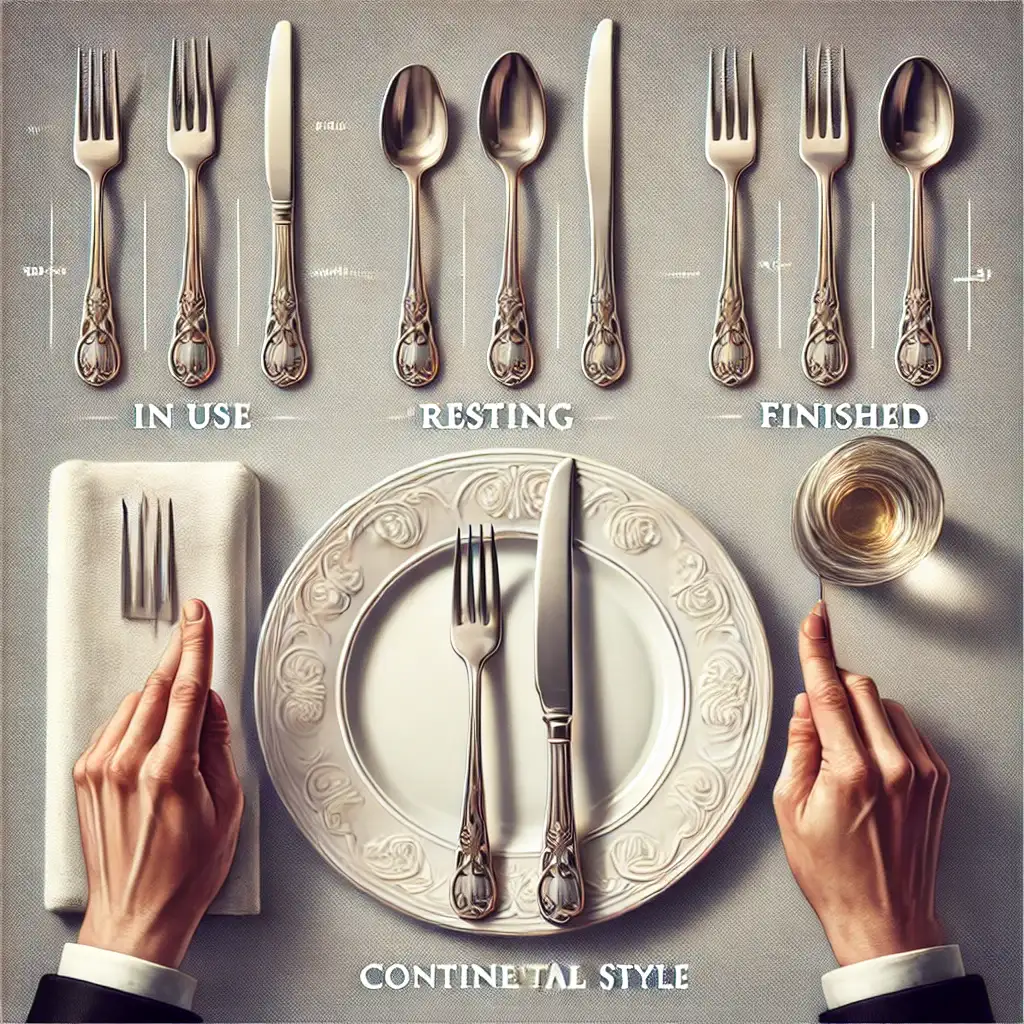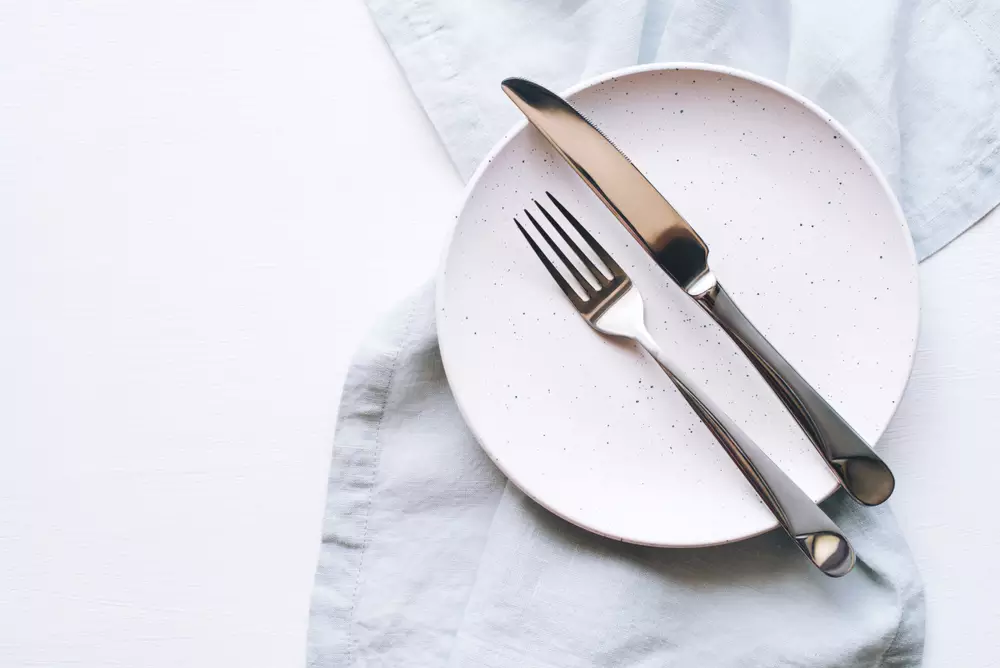Are you tired of wondering how to place your cutlery after eating? We’ve all been there: confused about whether to put them on a napkin, leave them on the plate, or even ask the wait staff for help. Although it’s a minor issue, it has a major effect on manners and etiquette.
This blog post will discuss the technique of how to place your cutlery neatly after dining. The days of clumsily messing with your forks and knives are over. So let’s get started and learn how to set up our cutlery!
How to Place Your Cutlery After Eating
Dining etiquette is a subtle yet significant part of social interactions. Among the myriad of unwritten dining rules, cutlery placement holds a key position. Knowing how to place your cutlery after eating is essential for conveying politeness and understanding dining customs across cultures.

Understanding Cutlery Signals
Cutlery signals have a rich history rooted in European dining traditions. They were developed to minimize miscommunication between diners and servers. For instance:
- Parallel Placement: Both knife and fork placed parallel across the plate signal you are finished.
- Crossed Cutlery: A fork and knife crossed on the plate typically indicate a pause or unfinished state.
These universal cues ensure smooth communication in any dining setting.

Basic Cutlery Placement Guidelines
Proper cutlery placement depends on whether you are finished or taking a break. Here’s a simple guide:
- Not Finished:
- Place your fork and knife in an inverted V shape (fork tines down) with tips touching.
- Finished:
- Lay both the knife and fork parallel, with handles resting on the plate’s rim.
The alignment and positions might vary slightly based on regional practices.
Finished Eating Signal
One universally recognized way to signal that you’ve finished your meal is by placing your cutlery in the “10:20 position” (like clock hands).
- In the European style, the knife blade and fork tines should point downwards.
- In the American style, tines may face upwards, and the knife blade should face inward.
This neat arrangement indicates to servers that they can clear your plate.

Not Finished Signal
When taking a break or pausing during the meal, place the fork and knife in a crossed or angled position. This placement prevents servers from mistakenly clearing your plate and indicates you plan to continue eating.

Cultural Differences in Cutlery Etiquette
Etiquette varies widely across cultures:
- Europe: Precision in placement is emphasized, with clear-cut rules for multi-course meals.
- United States: A relaxed approach where even casual diners recognize basic signals.
- Asia: Chopstick etiquette often replaces cutlery rules, emphasizing resting positions.
Understanding these nuances demonstrates respect for local customs.
How is the Continental style of eating done?
The Continental style of eating is considered to be a more elegant and refined way of dining, although it does require some practice to master. In this style, the fork is held in the left hand with the tines pointed downwards, while the knife is held in the right hand. The food is speared onto the fork and then brought to the mouth.
In between bites, the resting position is adopted. This involves crossing the knife and fork in the center of the plate, with the fork tines still pointing downwards. To signal the end of the meal, the “I am finished” position is assumed, which is similar to the American style with a slight difference. The knife and fork are placed side by side on the right side of the plate, specifically at the 4 o’clock position. However, in the Continental style, the tines of the fork are placed downwards instead of upwards, and the knife is positioned on the outside with the blade facing inwards.

How is the American style of eating done?
The American style of eating involves a unique method, commonly referred to as the “zigzag method.” Unlike many other cultures, Americans and Canadians hold the knife in their right hand (unless left-handed) and the fork in their left hand. To begin eating, the knife is used to cut the food while it is held in place by the fork. Once the desired piece of food is cut, the knife is placed near the top of the plate with the blade facing inwards. At this point, the fork is transferred from the left hand to the right hand and used to pick up the cut piece of food, with the tines facing upwards.
During pauses in eating, but before finishing the meal, the utensils are placed in a specific “resting position” on the plate. The knife is positioned on the right side of the plate, around the 4 o’clock position, with the blade facing inwards. Simultaneously, the fork is placed on the left side of the plate, approximately at the 8 o’clock position, with the tines pointing upwards. This particular arrangement serves as a visual signal for the waiter, indicating that the diner has temporarily suspended their eating and is not yet finished.
Once the meal is completely finished, the knife and fork are arranged together on the right side of the plate in the 4 o’clock position. The fork is positioned on the inside, with the tines facing upwards, while the knife is placed on the outside with the blade facing inwards. This particular arrangement acts as a non-verbal indication to the wait staff that the diner has completed their meal and is ready for their plate to be cleared.
Although it may be apparent that the diner has finished, a well-trained waiter might still ask, “Are you finished?” In response, a simple affirmative reply, accompanied by a smile and a “thank you,” is appropriate.

What are the two different styles of eating in North America?
In North America, there are two commonly used styles of eating, known as the “American style” and the “Canadian style.” These styles involve different techniques for holding and using utensils while dining.
In the American style, which is also known as the “zigzag method,” individuals typically hold the knife in their right hand (though left-handed individuals may do the opposite) and the fork in their left hand. When cutting food, the knife is used to slice through it while it is held in place by the fork. After cutting a piece of food, the knife is placed near the top of the plate with the blade facing inwards. Then, the fork is transferred to the right hand to pick up the cut piece of food, holding it with the tines facing upwards. When taking a break during the meal, the utensils are placed in the “resting position,” where the knife is positioned on the right side of the plate in the 4 o’clock position (blade inwards) and the fork is placed on the left side in the 8 o’clock position (tines up).
This arrangement signals to the waiter that the diner is not finished yet. Finally, when the meal is completed, the knife and fork are placed side by side on the right side of the plate in the 4 o’clock position. In this “I am finished” position, the fork is positioned on the inside, with its tines facing upward, and the knife is placed on the outside, with its blade facing inward. This configuration serves as a non-verbal signal to the wait staff that the plate is ready to be cleared. Although it might be evident that the diner has finished eating, a well-trained waiter may still inquire, “Are you finished?” to which the diner can respond with a smile and a “yes, thank you.”
The Canadian style of eating also involves holding the fork in the left hand, but the main difference lies in the use of the knife. In this style, the knife is held in the right hand, similar to the American style for right-handed individuals. However, when cutting food, the Canadian style differs as the fork is used to secure the food, and the knife is held as support for cutting. Once the food is cut, the knife is placed on the plate with the blade facing inwards, and the fork is used to pick up the cut piece of food.
Similarly, during breaks or when indicating the meal is not yet finished, the resting position of the utensils follows the same pattern as the American style. When finished eating, the knife and fork are placed side by side on the right side of the plate, with the fork positioned on the inside, tines facing upward, and the knife on the outside, blade facing inward. This final arrangement serves as the signal for wait staff to clear the plate. As with the American style, a polite inquiry from the waiter may still take place to confirm if the diner has finished their meal. In such cases, a positive response is given with a smile and a “yes, thank you.
The Importance of Proper Cutlery Placement
The importance of proper cutlery placement at the dining table cannot be understated. It is more than just being polite; it reflects your politeness, your respect for others, and your awareness of cultural differences. Here’s why it matters:
- Respect for Tradition: Proper cutlery placement is deeply rooted in tradition and etiquette. It honors the traditions that have developed over many years. By following these rules, you show that you are willing to respect and honor traditional practices.
- Politeness and Consideration: Placing your cutlery correctly is a form of politeness and consideration for your fellow diners. It ensures that your utensils do not interfere with their personal space or the serving staff’s ability to clear your table efficiently. It’s a way of showing that you care about the comfort and experience of those around you.
- Professional and Social Advancement: In both social and business settings, it can be important to know how to handle formal eating situations. Meals are frequently served at business dinners, interviews, and networking events, so knowing where to set your cutlery can help you create a good impression.
- Cultural Sensitivity: Different cultures have varying rules for cutlery placement. Understanding and following these rules when dining with people from diverse backgrounds demonstrates your cultural sensitivity and openness to learning about and respecting other traditions.
- Enhanced Dining Experience: Proper cutlery placement contributes to an enhanced dining experience. It allows you to focus on the food and the conversation rather than worrying about whether you are committing a dining faux pas. When you’re comfortable with the etiquette, you can relax and enjoy the meal and the company.
- Personal Growth: Dining etiquette instruction and practice can be an important part of personal development. It’s a talent that can increase your confidence and trust in a variety of social situations. You’ll notice that you feel your best when dining out as you get more used to the right utensil positioning.

Basic Rules for Cutlery Placement
Understanding the fundamentals of cutlery placement is an essential beginning in showing suitable table manners and etiquette. Here is a breakdown of the key rules to remember while positioning your silverware before, during, and after a meal:
- The “Rest” Position:
- After using your knife and fork during the meal, position them in the “rest” position.
- Place the knife on the right side of your plate with the blade facing inward.
- The fork should be on the left side of your plate.
- Align the knife blade and fork tines in an inverted “V” shape on your plate, with both utensils pointing towards the center of the plate.
- The “Finished” Position:
- Once you’ve completed your meal, signal that you’re finished to the server by placing your knife and fork in the “finished” position.
- Position the knife and fork parallel to each other on your plate.
- Imagine your plate as a clock face; the knife and fork should create a straight line at approximately the 4:20 position.
- This placement communicates to the staff that they can clear your plate.
- Avoid Crossing:
- Never cross your cutlery on your plate. Crossing your knife and fork is considered impolite and can be interpreted as a sign that you’re dissatisfied with the meal or still hungry.
- Keep your utensils side by side, with the knife on the right and the fork on the left, in the “rest” or “finished” position.
- Napkin Placement:
- When you need to briefly leave the table, place your cutlery in the “finished” position, indicating you are temporarily done with your meal.
- Fold your napkin neatly and place it to the left of your plate.
- Upon returning to the table, your place setting will remain intact, and you can continue your meal.
Tips for Casual Dining Settings
Even in everyday meals, proper cutlery placement shows attention to detail. Use simpler versions of formal signals, such as:
- Aligning cutlery neatly at the plate’s edge when finished.
- Resting cutlery on the plate rim when pausing.
Tips for Dining in a Group
Coordinating signals in group dining scenarios is equally important. For example, finishing your meal too early and signaling “done” while others are still eating can make others feel rushed.
Common Mistakes to Avoid
- Resting Cutlery Haphazardly: This can create confusion for servers.
- Crossing the Cutlery When Finished: In some cultures, this can signal dissatisfaction.
Small missteps can detract from the dining experience.
Conclusion
Knowledge of the proper silverware placement goes beyond keeping with convention; it also shows respect, consideration, and cultural sensitivity. Whether you’re at a formal event or a casual lunch with friends, knowing the right dining etiquette basics like where to put your utensils after eating will improve your dining experience.
So keep in mind, how to place your cutlery after eating. Speaks volumes about your etiquette and presents you attractively in a diner.
FAQ:
Q: How should I organize my cutlery in a drawer for easy access?
- A: Consider using drawer organizers to separate different types of cutlery. Place spoons, forks, and knives in designated sections to streamline access.
Q: What’s the proper way to set a formal dining table with cutlery?
- A: Follow traditional etiquette by placing forks on the left, knives on the right, and spoons to the right of the knife. Set specialty utensils based on the courses you’re serving.
Q: Are there specific rules for arranging cutlery in a casual dining setting?
- A: While casual settings allow for a more relaxed approach, a common arrangement is to place forks on the left, knives on the right, and spoons next to the knife.
Q: How can I organize cutlery in a small kitchen without drawers?
- A: Utilize countertop organizers, magnetic strips, or wall-mounted racks to save drawer space. Group similar utensils together for easy access.
Q: What’s the best way to store sharp knives to ensure safety?
- A: Use a knife block, magnetic strip, or in-drawer knife organizer to keep knives secure and blades protected. Avoid storing loose knives in a drawer to prevent accidents.
Q: Should I separate everyday cutlery from special occasion pieces?
- A: Consider keeping everyday cutlery easily accessible in the kitchen and storing special occasion or formal cutlery separately for occasional use.
Q: Are there creative ways to display cutlery in the kitchen for both function and decor?
- A: Yes, you can use wall-mounted racks, countertop caddies, or even repurposed containers to display cutlery. This adds a decorative touch while keeping utensils within reach.
Q: How do I organize cutlery for a buffet or self-serve setting?
- A: Arrange cutlery in a way that guests can easily grab what they need. Consider using utensil caddies or placing sets at various points on the buffet table.
Q: Can I mix and match different styles of cutlery in a single setting?
- A: Yes, mixing styles can add an eclectic touch to your table setting. Just ensure a cohesive overall look by considering similar finishes or themes.
Q: What’s the best way to clean and maintain cutlery for long-lasting use?
- A: Hand wash cutlery promptly after use, dry them thoroughly to prevent rust, and avoid using abrasive materials. Regularly sharpen knives to maintain their effectiveness.